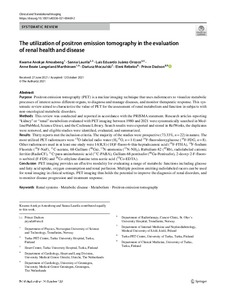The utilization of positron emission tomography in the evaluation of renal health and disease
Marthinsen Anne BL; Rebelos Eleni; Moczulski Dariusz; Juarez-Orozco Luis E; Dadson Prince; Laurila Sanna; Amoabeng Kwame A
https://urn.fi/URN:NBN:fi-fe2021120158397
Tiivistelmä
Purpose
Positron emission tomography (PET) is a nuclear imaging technique that uses radiotracers to visualize metabolic processes of interest across different organs, to diagnose and manage diseases, and monitor therapeutic response. This systematic review aimed to characterize the value of PET for the assessment of renal metabolism and function in subjects with non-oncological metabolic disorders.
Methods
This review was conducted and reported in accordance with the PRISMA statement. Research articles reporting “kidney” or “renal” metabolism evaluated with PET imaging between 1980 and 2021 were systematically searched in Medline/PubMed, Science Direct, and the Cochrane Library. Search results were exported and stored in RefWorks, the duplicates were removed, and eligible studies were identified, evaluated, and summarized.
Results
Thirty reports met the inclusion criteria. The majority of the studies were prospective (73.33%, n = 22) in nature. The most utilized PET radiotracers were 15O-labeled radio water (H215O, n = 14) and 18F-fluorodeoxyglucose (18F-FDG, n = 8). Other radiotracers used in at least one study were 14(R,S)-(18)F-fluoro-6-thia-heptadecanoic acid (18F-FTHA), 18F-Sodium Fluoride (18F-NaF), 11C-acetate, 68-Gallium (68Ga), 13N-ammonia (13N-NH3), Rubidium-82 (82Rb), radiolabeled cationic ferritin (RadioCF), 11C‐para-aminobenzoic acid (11C-PABA), Gallium-68 pentixafor (68Ga-Pentixafor), 2-deoxy-2-F-fluoro-D-sorbitol (F-FDS) and 55Co-ethylene diamine tetra acetic acid (55Co-EDTA).
Conclusion
PET imaging provides an effective modality for evaluating a range of metabolic functions including glucose and fatty acid uptake, oxygen consumption and renal perfusion. Multiple positron emitting radiolabeled racers can be used for renal imaging in clinical settings. PET imaging thus holds the potential to improve the diagnosis of renal disorders, and to monitor disease progression and treatment response.
Kokoelmat
- Rinnakkaistallenteet [19249]
